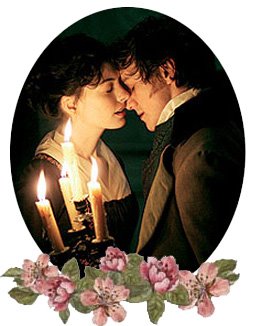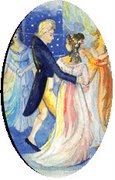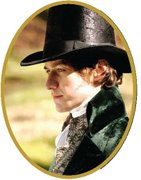Mansfield Park: Jane Austen’s Tribute to Tom Lefroy
 Are we mistaken in considering ‘Mansfield Park’ as a silent homage to [Jane’s] Irish friend? (Radovici 1995, p. 70).
Are we mistaken in considering ‘Mansfield Park’ as a silent homage to [Jane’s] Irish friend? (Radovici 1995, p. 70).
I have read the quote above a few months ago as I acquired my copy of Radovici’s A Youthful Love from dearest Linda. Yet, I have never got the chance or interest to look deeper into
Now, many biographers and scholars think of MP as a different kind of Austen book, unlike her other works. Back when MP was first published, not many of Jane’s family and friends favoured the book (check Republic of Pemberley). Even Mrs. Austen thought that Fanny Price was ‘insipid’. Indeed, Wikipedia says that MP ‘is the most controversial and perhaps the least popular of Austen's major novels.’ In short, a truly out-of-place book.
It was indeed what I thought until I read it with Jane’s view point of Tom Lefroy. With such a POV, information jumped easily out of the pages to reveal the other layers not yet seen, with the exception by dear Radovici. Hence, this is the first of several articles on the meaning of
Reference of Tom Lefroy in
Jane wrote MP from February 1811 to 1814 and published it on May 9th, 1814 (Austen-Leigh 1871). First, the initial. MP = Mansfield Park. But it can also mean Mary Paul (!), or Member of Parliament. The last one is tricky, for in 1811-14, Thomas Langlois Lefroy was not an MP yet (he became an MP in 1830). But it's just... a strange coincident. Then, Volume I Chapter 1, first paragraph:
About thirty years ago Miss Maria Ward, of Huntingdon, with only seven thousand pounds, had the good luck to captivate Sir Thomas Bertram, of Mansfield Park, in the county of Northampton, and to be thereby raised to the rank of a baronet's lady, with all the comforts and consequences of an handsome house and large income. All Huntingdon exclaimed on the greatness of the match, and her uncle, the lawyer, himself, allowed her to be at least three thousand pounds short of any equitable claim to it. She had two sisters to be benefited by her elevation; and such of their acquaintance as thought Miss Ward and Miss Frances quite as handsome as Miss Maria, did not scruple to predict their marrying with almost equal advantage. But there certainly are not so many men of large fortune in the world as there are pretty women to deserve them. Miss Ward, at the end of half a dozen years, found herself obliged to be attached to the Rev. Mr. Norris, a friend of her brother-in-law, with scarcely any private fortune, and Miss Frances fared yet worse. Miss Ward's match, indeed, when it came to the point, was not contemptible: Sir Thomas being happily able to give his friend an income in the living of Mansfield; and Mr. and Mrs. Norris began their career of conjugal felicity with very little less than a thousand a year. But Miss
Forget Maria Ward or Frances Ward for a moment. What happened to Jane Austen and Tom Lefroy thirty years from a certain time point?
Jane met Tom in Christmas 1795. Thirty years beforehand, 1765 was... the secret wedding of Anthony Peter Lefroy and Ann Gardner; i.e. Tom Lefroy's parents. November 15th, 1765, to be exact (Cranfield 1960). Hence, in the first sentence of MP, Jane already stated that
Sir Thomas Bertram had interest, which, from principle as well as pride--from a general wish of doing right, and a desire of seeing all that were connected with him in situations of respectability, he would have been glad to exert for the advantage of Lady Bertram's sister; but her husband's profession was such as no interest could reach; and before he had time to devise any other method of assisting them, an absolute breach between the sisters had taken place. It was the natural result of the conduct of each party, and such as a very imprudent marriage almost always produces.
It is possible that Sir Thomas Bertram (STB) referred to Tom Lefroy himself who helped brother Anthony after Ben Langlois ditched him. But, with all due respect to my dear AR/O, I think STB was more of Benjamin Langlois, who was a snobbish man in nature, and certainly wanted to protect his family's name (though STB could also be the portrayal of Tom himself). Now, Michelle also pointed out that apparently Tom Lefroy's sister's disagreed over his choice of bride (i.e. Mary Paul). Interestingly, Lady Bertram and Mrs Norris bickered with their sister over her choice of husband.
I consent, because the 1979 Huguenot paper by JAP Lefroy also indicated that Tom's sisters were NOT happy with Tom’s marriage with Mary (thanks to Arnie for the paper!). I am not certain of the cause, perhaps because the sisters wanted to grab Thomas Paul (Mary's brother) instead. But, certainly the unhappiness was not about Jane. I doubt that Tom's sisters were well-versed of Jane Austen.

Then, still Chapter 1, second paragraph (JA's paragraphs are long, eh?):
By the end of eleven years Mrs. Price could no longer afford to cherish pride or resentment, or to lose one connection that might possibly assist her.... she addressed Lady Bertram in a letter.[bolded words by Icha]
Counting 11 years from 1765 was... bingo! 1776. The year Tom Lefroy was born. Radovici explained that only after Tom's birth did Tom's parents tell Ben Langlois of their marriage. And of course, Mrs. Price then sent Fanny, her ELDEST daughter, to the place of her rich sister's. And of course we know that Tom was the eldest son of his family. Plus, Mrs. Norris had no offspring…the way Ben Langlois had no son/daughter at all. Could it be that Fanny Price was actually Tom Lefroy?
Now, this is what Wikipedia said about Fanny Price:
A daughter in a family of nine who is sent to live with her mother's sisters at
A daughter of nine. Well, Tom was a son of eleven, but then two of his siblings (Catherine, 3rd Dec 1805 and Christopher, 14th Feb 1805) died. Hence, by the time MP was written (1811/14), Tom was a son of NINE, who had been sent to live with his father's relative. And was he not a reserved person? A shy person whom Jane loved to tease? A sensitive soul?
That's Fanny Price, who had a lot of Tom in her. Fanny, who often feared the presence of Sir Thomas Bertram (and we doubt that Tom saw Benjamin Langlois as someone not to be feared of). Fanny, who in Chapter 4 had an old grey poney (The ensuing spring deprived her of her valued friend the old grey poney). Later, Cousin Edmund Bertram gave her a horse, a true mare, and she liked it, though ‘She had not supposed before, that any thing could ever suit her like the old grey poney.’
Now, Jane Austen did not have a pony. She had a donkey instead (Letter #142, July 9th, 1816: ‘we set off in the Donkey Carriage for Farringdon’). Now let’s see p. 382 of the Memoir of Chief Justice Lefroy:
He always enjoyed riding more than any other exercise, and, whenever the weather permitted, he continued, up to the year of his death, to take his morning or afternoon ride on a favourite pony which he had had for more than thirty years.
Tom Lefroy loved riding horse... to be precise, a PONY which he had had since 1830s, when he was in his 60s. Could JA be alluding to Tom with the poney? That Tom actually had loved ponies since he was a teenager (perhaps even owned a grey one), and told Jane about it? Jane then used it to indicate that Fanny Price was actually Tom Lefroy.
There was another character that was inspired by Tom, i.e. Fanny’s cousin, Edmund Bertram. Wikipedia says that Edmund was:
The younger son of Sir Thomas and Lady Bertram; he is six years older than Fanny. He plans to be a clergyman. He alone among his family has any consideration for Fanny's feelings. As her protector and friend, he has a great deal of influence over her and helps to form her character. Edmund becomes attracted to Miss Crawford.
Didn't Tom want to be a clergyman? Or at least, he was VERY religious. And he was kind and a good listener, I bet not unlike the real Tom Lefroy himself, to whom the chatty Jane fell in love. And Edmund was attracted to a Mary Crawford. In real life, we know that Tom finally married Mary Paul.
Hence, in Mansfield Park, Tom Lefroy was at least portrayed in both Fanny Price and Edmund Bertram, her cousin she later married to. However, there are instances where Jane Austen inserted herself in Fanny's story, as we will read in the following sections.
Anthony Lefroy in
Jane Austen had many references for her characters in MP. Unexpectedly for me, had I not learned about Anthony before, Jane also inserted Anthony in MP. As we know, the generous Edmund had an elder brother, Thomas Bertram, who – according to Wikipedia – was:
The elder son of Sir Thomas and Lady Bertram; he is seven years older than Fanny. Tom is principally interested in carousing in
Now, the 1979 JAP paper has something about dear Anthony Lefroy (p. 155):
His [Tom's] brother Anthony had followed his father into the Army. He had a disastrous career, being constantly in debt and having to be bailed out by great-uncle Benjamin. Finally, as mentioned above, he made what was regarded as an unsuitable marriage and his great-uncle, in letters full of furious invective, cut him off completely. he had to sell his commission and leave the Army. Thomas, however came to his assistance. Using his influence with the Government he obtained for his brother the lowly but reasonably paid post of Barrack Master at
Michelle also found something in the first paragraphs of Chapter 3:
The living was hereafter for Edmund; and, had his uncle died a few years sooner, it would have been duly given to some friend to hold till he were old enough for orders. But Tom's extravagance had, previous to that event, been so great as to render a different disposal of the next presentation necessary, and the younger brother must help to pay for the pleasures of the elder. There was another family living actually held for Edmund; but though this circumstance had made the arrangement somewhat easier to Sir Thomas's conscience, he could not but feel it to be an act of injustice, and he earnestly tried to impress his eldest son with the same conviction, in the hope of its producing a better effect than anything he had yet been able to say or do.
"I blush for you, Tom," said he, in his most dignified manner; "I blush for the expedient which I am driven on, and I trust I may pity your feelings as a brother on the occasion. You have robbed Edmund for ten, twenty, thirty years, perhaps for life, of more than half the income which ought to be his. It may hereafter be in my power, or in yours (I hope it will), to procure him better preferment; but it must not be forgotten that no benefit of that sort would have been beyond his natural claims on us, and that nothing can, in fact, be an equivalent for the certain advantage which he is now obliged to forego through the urgency of your debts." [bolded parts by Icha]
By now, we know that Tom Lefroy had to lose his future; because of marrying Lizzy Wilkin, Anthony had robbed his brother Tom for ten, twenty, thirty years, perhaps for life... Though beforehand, there was actually another family living held for Tom Lefroy. Not with Mary Paul… but with Jane Austen.
But, perhaps Anthony was not that evil. He was a pitiable mess indeed, but Tom still cared for him, and I believed, vice versa. For it is also said that 'Tom [Bertram] listened with some shame and some sorrow'. It means that he, to Jane’s perspective at least, held some remorse.
It’s interesting to think of Jane’s perception of Anthony Lefroy. Chapter 5 page 45 (Penguin 2003) mentioned another thing about Thomas Bertram:
Tom Bertram must have been thought pleasant, indeed, at any rate; he was the sort of young man to be generally liked, his agreeableness was of the kind to be oftener found agreeable than some endowments of a higher stamps, for he had easy manners, excellent spirits, a large acquaintance, and a great deal to say... [bolded words by Icha]
Watch the must have been thought; for it means that this is truly the narrator's (Jane's) POV, despite trying to get into the head of Mary Crawford. I mean, in describing Fanny and Edmund, Jane did not use the 'must have been thought' style. Hence, it means that Jane was also not sure what kind of person Tom Bertram exactly was. Or, Anthony Lefroy, to be precise. But from Tom Lefroy's descriptions of his younger brother, Jane concluded that, from the outside, Anthony must be an amiable man; at least his manners were agreeable. Cheerful person, in comparison to Tom's shy and reserve nature.
Irish Reference in
Now, we cannot talk of Tom Lefroy without talking of
“But, aunt, she is really so very ignorant! - Do you know we asked her last night, which way she would go to get to
Not unlike the way Jane Austen 'used' Frank Churchill to tell about Jane Fairfax/Austen or Lizzy to tell about Jane Bennet/Austen, here she also used Fanny's cousin to tell how Jane herself always thought of nothing but the Isle... the
The way Fanny Price could not think of another
Christmas holiday in
Once and once only in the course of many years had she the happiness of being with William…Luckily the visit happened in the Christmas holidays, when she could directly look for comfort to her cousin Edmund, and he told her of such charming things of what William was to do, and be hereafter, in consequence of his profession, as to make her gradually admit that the separation might have some use…In return of such services she loved him better than any body in the world except William; her heart was divided between the two. [bolded parts by Icha]
From the passage, we learn that Fanny's greatest happiness (so far) took place during the Christmas holidays. Michelle suggested that Fanny (Jane) enjoyed the company of William (Tom – JA often switched characters), while applying to Edmund (Cassandra) for comfort and support for the upcoming separation. I totally agree. After meeting Tom Lefroy, Jane Austen’s heart would be torn between her sister Cass and Tom.
Tom’s trust in Jane
On scanning, five first chapters are already full of Ireland/Tom Lefroy references. What about the ENTIRE book? Can't imagine that; too scary! Michelle already bombarded me with more and more analysis, I had to request her to slow down :-D
Another very important thing: since clearly here Jane talked about Benjamin Langlois, Tom's parents (and sisters perhaps) brother and Anthony, it means that Jane was Tom's confidant. He entrusted her the 'dirty family business' of the Lefroys. To me, she was MORE than a fling to him. Much more than a simple winter flirtation.
Jane could not possibly know these all from Mrs. Anne Lefroy; Anne would not relay such embarrassing news to her young friend. No. I am certain that Tom Lefroy himself told Jane about his family problems. And how could Jane now about Anthony, of all people, in details if Tom did not tell her? That means another thing: if it's true that MP was alluding to Anthony's 'unfortunate' marriage as well (in addition to his fathers' - Anthony Peter Lefroy's - marriage), hence after Anthony's wedding, Tom still had time to tell Jane of what truly happened. It could be right after November 1798... or before the March 1799 wedding... or afterwards.
For as Arnie said from the first letter of Mrs. Lefroy (Rachel is trying to obtain the book for me), Tom and his father (Anthony Peter Lefroy) visited Ashe in early Oct 1800. And there was a long gap in Jane's letters then (more than a year, after
Dear friends, I hope this post triggers your interest in reading Mansfield Park now. I find it a very interesting book after I read it with Tom Lefroy perspective. Perhaps I should not do that. Perhaps I just read it as it is: a novel, full stop. But I cannot believe that Jane scattered so many hints on Tom Lefroy in Sense & Sensibility, Pride & Prejudice, Emma, Northanger Abbey and (of course) Persuasion, but left Mansfield Park out. It is, to me, unthinkable. To me,
'Mansfield Park’ is above all a book about the difficulty of preserving true moral consciousness in the selfish maneuvering of society…After one has read the ‘Memoir of Chief Justice Lefroy’, after one has learned of Thomas Lefroy's lifelong struggle to maintain true values in a changing world, ‘Mansfield Park’ – sometimes described as 'a strange book' acquires a deeper meaning.
Reference:
Austen-Leigh, J. E. 1871, A Memoir of Jane Austen and Other Family Recollections (2002 Oxford edition), Oxford World's Classics, Oxford.
Austen, J. 1814, Mansfield Park (2003 edition), Penguin, London.
Austen, J. 1815, Emma (2003 edition), Penguin, London.
Cranfield, R. E. 1960, From Ireland to Western Australia: The Establishment of a Branch of the Lefroy Family at Walebing, Western Australia, 1842 to 1960, Service Printing Perth.
Faye, D. L. 1997, Jane Austen's Letters, Oxford University Press, Oxford.
Lefroy, J. A. P. 1979, 'Jane Austen's Irish Friend', Huguenot Society Proceedings, vol. 23, pp. 148-165.
Lefroy, T. 1871, Memoir of Chief Justice Lefroy, Hodges, Foster & Co., Dublin.
Radovici, N. 1995, A Youthful Love: Jane Austen and Tom Lefroy?, Merlin Books Devon.
Pic 2: Cover to
Pic 3: Edmund Bertram (Jonny Lee Miller) and Fanny Price (Frances O’Connor), jimandellen.org
Pic 4: Edmund comforting Fanny, Republic of Pemberley
Pic 5: the 2007
Pic 6: A Joan Hassall woodcut for

























































